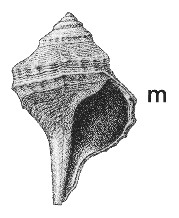
Revised descriptions of New Zealand Cenozoic Mollusca from Beu and Maxwell (1990)

 | Revised descriptions of New Zealand Cenozoic Mollusca from Beu and Maxwell (1990) | 
|
  (Pl. 2m): GS1494, M46/f9500, Wangaloa, Wangaloan (GNS) |
Beu & Maxwell (1990): Chapter 5; p. 84; pl. 2 m.
Synonymy: Tudiclana simulator Finlay & Marwick 1937, p. 70
Type species of Tudiclana Finlay & Marwick, 1937
Classification: Turbinellidae: Vasinae?
Description: Rather small for family (height 20-35 mm), pyriform, spire low. Protoconch apparently small, mamillate. Teleoconch whorls shouldered at or below middle on spire, sutural ramp almost flat. Last whorl with 3 or 4 prominent subequal keels, periphery broadly angled, strongly excavated below to form long, straight neck. Axial sculpture of small, rather sharp tubercles on keels and subdued collabral costae or ridges between keels. Tubercles much more prominent on 2 adapical keels than below; 20-25 on penultimate whorl. Spiral sculpture of narrow cords on keels and numerous much finer threads, some with even finer interstitial threads, over whole teleoconch surface. Aperture pyriform with a moderately long, open siphonal canal; columella almost straight with a low fold not visible from in front, above inception of canal. Inner lip thinly and narrowly callused; outer lip with a shallowly arcuate sinus on ramp, slightly convex and opisthocline below.
Comparison: Tudiclana simulator is readily distinguished from Microfulgur longirostris by its lower spire, its tuberculate sculpture and its almost straight columella. Tudiclana is apparently closely related to Tudicla Roding, 1798, a genus that is first recorded from the Late Cretaceous and is represented in the modern fauna by a single species from the Bay of Bengal (Abbott 1959). It differs from Tudicla in its smaller size, having tuberculate sculpture, an unarmoured outer lip and a much weaker columellar fold, and in lacking a parietal plait. Rosenberg & Petit (1987, p. 58-60) discussed the confusion over Tudicla Roding, 1798, Tudicula H. & A. Adams, 1864, and the senior homonym Tudicula Ryckholt, 1862, provided the new name Tudivasum for Tudicula H. & A. Adams (preoccupied), and placed both Tudicla and Tudivasum in the Turbinellidae Vasinae (following Abbott 1959). Rosenberg & Petit (1987, p. 60) listed Tudicula sulcata Marshall, 1917 (= Microfulgur longirostris) among species incorrectly assigned to Tudicula. Perissitys Stewart, 1927, which is based on a Late Cretaceous species from California, is close to Tudiclana in sculpture but has two prominent folds or pseudofolds on the columella; it has recently been placed in its own family, Perissityidae (Popenoe and Saul 1987), but by the criteria of Rosenberg & Petit (1987) belongs in Turbinellidae Vasinae. The family position of Fyfea, Microfulgur, Tudiclana, Taioma and Heteroterma is unclear, and we have tentatively left Taioma in Taiomidae, and refer the others tentatively to Turbinellidae Vasinae.
Distribution: Wangaloan, Boulder Hill (type) (common); Wangaloa (very rare).
Cite this publication as: "A.G. Beu and J.I. Raine (2009). Revised
descriptions of New Zealand Cenozoic Mollusca from Beu and Maxwell (1990). GNS
Science miscellaneous series no. 27."
© GNS Science, 2009
ISBN
978-0-478-19705-1
ISSN 1177-2441
(Included with a PDF facsimile file
copy of New Zealand Geological Survey Paleontological Bulletin 58 in CD version
from: Publications Officer, GNS Science, P.O. Box 30368 Lower Hutt, New
Zealand)